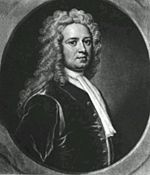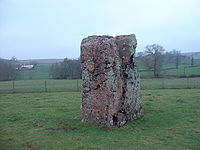Stanton Drew stone circles: Difference between revisions
Created page with "right|thumb|350px|Stanton Drew stone circles {{county|Somerset}} The '''Stanton Drew stone circles''' are just outside the village of ..." |
|||
| Line 49: | Line 49: | ||
==Myths about Stanton Drew== | ==Myths about Stanton Drew== | ||
There are several local traditional stories about the megalithic complex. The best known tells how a wedding party was turned to stone: the party was held throughout Saturday, but a man clothed in black (the Devil in disguise) came and started to play his violin for the merrymakers after midnight, continuing into Sunday morning, thus defying the Lord's Day. When dawn broke, everybody had been turned to stone by the Demon. The stone circles then are the dancers, the avenues are the fiddlers and The Cove is the bride and the groom with the drunken churchman at their feet. They are still awaiting the Devil who promised to come back some day and play again for them.<ref name=ehhistandres/><ref>{{cite web|title=Stanton Drew Stone Circle|url=http://www.haunted-britain.com/stanton-drew.htm|publisher=Haunted Britain|accessdate=28 April 2014}}</ref><ref>{{cite web|title=Stanton Drew Stone Circle|url=http://www.mysteriousbritain.co.uk/england/avon/ancient-sites/stanton-drew-stone-circle.html|publisher=Mysterious Britain and Ireland|accessdate=28 April 2014}}</ref><ref>{{cite web|title=Stanton Drew Circles and Cove:History and Research|url=https://www.english-heritage.org.uk/daysout/properties/stanton-drew-circles-and-cove/history-and-research/|publisher=English Heritage|accessdate=28 April 2014}}</ref> | There are several local traditional stories about the megalithic complex. The best known tells how a wedding party was turned to stone: the party was held throughout Saturday, but a man clothed in black (the Devil in disguise) came and started to play his violin for the merrymakers after midnight, continuing into Sunday morning, thus defying the Lord's Day. When dawn broke, everybody had been turned to stone by the Demon. The stone circles then are the dancers, the avenues are the fiddlers and The Cove is the bride and the groom with the drunken churchman at their feet. They are still awaiting the Devil who promised to come back some day and play again for them.<ref name=ehhistandres/><ref>{{cite web|title=Stanton Drew Stone Circle|url=http://www.haunted-britain.com/stanton-drew.htm|publisher=Haunted Britain|accessdate=28 April 2014}}</ref><ref>{{cite web|title=Stanton Drew Stone Circle|url=http://www.mysteriousbritain.co.uk/england/avon/ancient-sites/stanton-drew-stone-circle.html|publisher=Mysterious Britain and Ireland|accessdate=28 April 2014}}</ref><ref>{{cite web|title=Stanton Drew Circles and Cove:History and Research|url=https://www.english-heritage.org.uk/daysout/properties/stanton-drew-circles-and-cove/history-and-research/|publisher=English Heritage|accessdate=28 April 2014}}</ref> | ||
Latest revision as of 22:53, 10 November 2015

The Stanton Drew stone circles are just outside the village of Stanton Drew in Somerset. The largest stone circle is the Great Circle, 371 feet in diameter and the largest stone circle in Britain after Avebury. The Great Circle is considered to be one of the largest Neolithic monuments to have been built. The date of construction is not known but is thought to be between 3000 and 2000 BC, which places it in the Late Neolithic to Early Bronze Age.[1] It was made a scheduled monument in 1982.[2]
The Great Circle was surrounded by a ditch and is accompanied by smaller stone circles to the north east and south west. There is also a group of three stones, known as The Cove, in the garden of the local pub. Slightly further from the Great Circle is a single stone, known as Hautville's Quoit. Some of the stones are still vertical, but the majority are now recumbent and some are no longer present.
The stone circles have been studied since John Aubrey's visit in 1664 with some excavations of the site in the 18th century. In the late 20th and early 21st centuries geophysical surveys have confirmed the size of the stone circles and identified additional pits and postholes. The Cove has been shown to be around one thousand years older than the stone circles.
A variety of myths and legends about the stone circles have been recorded, including one about dancers at a celebration who have been turned to stone.
Monument


The most famous feature at Stanton Drew is the Great Circle, the second largest stone circle in Britain, exceeded only by Avebury. The circle is 371 feet in diameter and probably consisted of 30 stones, of which 27 survive today.[3] It was recorded by both John Aubrey in 1664 and William Stukeley in 1776.[4]
The Great Circle probably was surrounded by the ditch (approximately 443 feet outer diameter — now filled in) of a henge.[5]
Other elements include:
- The North East Circle is 100 feet in diameter and probably consisted of 10 or more stones, of which 8 survive today.
- The South West Circle is 141 feet in diameter, and has 12 stones surviving today.
- An avenue extends to the northeast of the Great Circle towards the River Chew and a second avenue meets it from the North East Circle.[6][7][2]
A (now recumbent) standing stone called Hautville's Quoit lies across the river to the north on an alignment with the centres of the Great Circle and the southern circle. It is a large stone close to Hautville Quoit Farm, recumbent since at least the mid 17th century but assumed to have originally been upright.[8] Described by Stukeley in 1723 as being 13 feet long,[9][10] it is now about half that length, Grinsell suggesting that fragments have occasionally been broken off for mending the roads. Stukeley also referred to the presence of a second stone.[11][12]

Further to the west is a cove of two standing stones with a recumbent slab between them, which can be found in the garden of the Druid's Arms public house. All are of different heights, the stone to the north east being 14 feet the south-western 10 feet, and the north-eastern 5 feet.[13] The stones of The Cove are mineralogically different from those in the nearby stone circles.
A long barrow burial chamber has been found under the stones of The Cove. It is thought that this predates the erection of the stones by approximately a thousand years.[14]
Study
Excavations
In 1740 the site was surveyed and mapped by John Wood, the Elder, who noted the different stones used. He suggested the layout was based on the Pythagorean planetary system,[15] and thought it was used as the Druid's "University".[16][17]
When one of the stones fell in the mid 17th century, some human bones were discovered accompanied by an object described as a "round bell, like a large horse-bell". The burial date and the purpose of the bell-like object are unknown.[18][19]
Geophysical survey

Geophysical work by English Heritage in 1997 revealed a surrounding ditch and nine concentric rings of postholes within the stone circle. More than four hundred pits, three feet across and at 8-foot intervals, stood in rings at the site.[4] The ditch is 443 feet in diameter and about 23 feet wide. A 131-foot wide entrance was visible on the north east side. No surrounding bank has been identified although the site awaits excavation.[5]
The geophysical work transformed the traditional view of Stanton Drew as being a surface monument and the Great Circle is now seen as being one of the largest and most impressive Neolithic monuments to have been built.[20][21][22] Analogous with the circles of postholes at sites at Woodhenge, Durrington Walls and The Sanctuary, it is thought that the pits would have held posts which would have either been freestanding or lintelled as they could not have supported a roof at that size. The postholes in nine concentric rings held posts up to three feet in diameter.[23]
Nearby and to the north-east is a smaller ring of eight stones in the centre of which the geophysical work identified four further pits. A third ring of twelve stones, measuring 47 yards wide, stands to the south west.[24]

A fluxgate gradiometer survey in July 2009 investigated standing stones in the garden of the Druids Arms public house known as The Cove, which showed that the stones date from nearly a thousand years before the stone circles. The conclusion from the study was that these upright stones are likely to have been the portals or façade of a chambered tomb.[25][26]
In 2010 a further survey was carried out by Bath and Camerton Archaeological Society and the Bath and North East Somerset Archaeological Officer. This involved high data density magnetometer, resistance pseudosection profiles and photographic surveys showed a new henge entrance and further detail of post holes.[24]
Myths about Stanton Drew
There are several local traditional stories about the megalithic complex. The best known tells how a wedding party was turned to stone: the party was held throughout Saturday, but a man clothed in black (the Devil in disguise) came and started to play his violin for the merrymakers after midnight, continuing into Sunday morning, thus defying the Lord's Day. When dawn broke, everybody had been turned to stone by the Demon. The stone circles then are the dancers, the avenues are the fiddlers and The Cove is the bride and the groom with the drunken churchman at their feet. They are still awaiting the Devil who promised to come back some day and play again for them.[4][27][28][29]
Modern myths and fancies are no rarer, throwing in the usual ley-lie ideas. Being a henge and stone circle site, astronomical alignments are a common theory to explain the positioning of the stones at Stanton Drew.[30][31][32]
Theories suggest the site was dedicated to funerary ritual.[33]
Wade and Wade in their 1929 book "Somerset" suggest:
One of the curiosities of the place is Hautville's Quoit, which, to save time, should also be looked for on approaching the village. (Enter iron gate on L. a few hundred yards before reaching tollhouse, and search backwards along the hedge bordering road.) It is a large stone, which legend says was hurled by Sir J. Hautville (whose effigy is in Chew Magna Church) from the top of Maes Knoll. The famous "druidical remains" will be found near the church. About 50 yards from the entrance to the churchyard take a lane to the L. leading to an orchard: the stones will be observed in the field beyond (admission free, but field closed on Sundays). The "remains" consist of three contiguous circles. The first is of considerable area, and is marked out by twelve large stones, only three of which remain upright; a smaller circle of eight stones lies just beyond; and a third circle of eight will be found farther away in an orchard on the R. The two larger circles have each a few scattered stones thrown off as a kind of avenue. Standing apart from the circles is a curious group of three stones huddled together in a garden abutting on the churchyard, from which they can be easily seen by looking over the W. boundary wall. These mystic rings probably had the same origin (whatever that may have been) as that of the more famous circle at Avebury in Wiltshire, with which they should be compared. The proximity of Maes Knoll is comparable with that of Silbury Hill. A ridiculous theory suggests that the monoliths were erected as a trophy after one of Arthur's victories. Arthur is connected to the site because a site in the nearby village of Camerley is reputed to be the location of Camelot in an oral tradition. The stones are of a reddish hue similar to that described in the Arthurian legend as connected to Camelot and to a sword that was seen in a stone near to Camelot. The country story is that a local wedding once took place on a Sunday, when the frivolous guests would insist on winding up with a dance. The penalty for a "Sabbath" thus "profaned" was the prompt transformation of the bridal party into stone. Hence the local appellation of "The fiddlers and the maids".[34]
Outside links
| ("Wikimedia Commons" has material about Stanton Drew stone circles) |
- Location map: 51°22’4"N, 2°34’31"W
- Stanton Drew Circles and Cove
- On Stanton Drew, Avebury and Stonehenge
References
- ↑ Oswin, John; Richards, John; Sermon, Richard. "Stanton Drew 2010 Geophysical survey and other archaeological investigations" (PDF). Bath and North East Somerset Council. p. 63. http://www.bathnes.gov.uk/sites/default/files/sd_2010_report_low_res.pdf. Retrieved 21 August 2014.
- ↑ 2.0 2.1 National Heritage List 1007911: Two stone circles and two stone avenues at Stanton Drew, east of Court Farm
- ↑ McIntosh 2009, p. 266.
- ↑ 4.0 4.1 4.2 Stanton Drew Circles and Cove: History and research
- ↑ 5.0 5.1 "Stanton Drew Stone Circles". English Heritage Archeometry. Archived from the original on 20 August 2006. http://web.archive.org/web/20060820140018/http://www.eng-h.gov.uk/archaeometry/StantonDrew/. Retrieved 8 July 2006.
- ↑ Bull, Larry. "On Stanton Drew, Avebury and Stonehenge". University of the West of England. http://www.bit.uwe.ac.uk/~lbull/stanton.html. Retrieved 1 December 2013.
- ↑ Pollard 2008, pp. 75-102.
- ↑ Richards, John. "Hautville's Quoit and other archaeological investigations at Stanton Drew, 2012" (PDF). Bath and Camerton Archaeological Society. http://www.bacas.org.uk/Reports/HQ2012reportsmall.pdf. Retrieved 7 February 2014.
- ↑ Dymond 1877, pp. 297-307.
- ↑ National Heritage List 1002475: Standing stone called Hautville's Quoit
- ↑ Strong 2012, p. 22.
- ↑ Burl 1993, p. 187.
- ↑ National Heritage List 1007916: Stone cove at Stanton Drew southwest of St Mary's Church
- ↑ "Study of Stanton Drew stone circle reveals new secrets". BBC. http://www.bbc.co.uk/news/uk-england-bristol-15375674. Retrieved 1 December 2013.
- ↑ Elliot 2004, p. 40.
- ↑ Haycock 2002, p. 220.
- ↑ Hutton 2009, p. 105.
- ↑ National Monuments Record: No. 201201 – Stanton Drew Great Circle
- ↑ Seyer 1821, p. 99.
- ↑ "Stanton Drew Stone Circles". Artetech Publishing. http://www.stonehenge-avebury.net/stantondrew/StantonDrew.html. Retrieved 1 December 2013.
- ↑ "Stanton Drew". Stone Pages. http://www.stonepages.com/england/stantondrew.html. Retrieved 2 May 2014.
- ↑ "Stanton Drew Timber Circle Digital Model". Digital Digging. http://digitaldigging.net/stanton-drew-timber-circle-digital-model/. Retrieved 2 May 2014.
- ↑ Strong 2008, p. 16.
- ↑ 24.0 24.1 Oswin, John; Richards, John; Sermon, Richard. "Stanton Drew 2010 Geophysical survey and other archaeological investigations" (PDF). Bath and North East Somerset. http://www.bathnes.gov.uk/sites/default/files/sd_2010_report_low_res.pdf. Retrieved 1 December 2013.
- ↑ "Stanton Drew – now 1000 years older". Bath and North East Somerset. 12 January 2010. Archived from the original on 29 July 2012. http://archive.today/rJWW. Retrieved 11 November 2010.
- ↑ Oswin, John; Richards, John; Sermon, Richard. "Geophysical Survey at Stanton Drew, July 2009" (PDF). Bath and Camerton Archaeological Society. http://www.bathnes.gov.uk/sites/default/files/sd_2009_report_low_res.pdf. Retrieved 12 December 2013.
- ↑ "Stanton Drew Stone Circle". Haunted Britain. http://www.haunted-britain.com/stanton-drew.htm. Retrieved 28 April 2014.
- ↑ "Stanton Drew Stone Circle". Mysterious Britain and Ireland. http://www.mysteriousbritain.co.uk/england/avon/ancient-sites/stanton-drew-stone-circle.html. Retrieved 28 April 2014.
- ↑ "Stanton Drew Circles and Cove:History and Research". English Heritage. https://www.english-heritage.org.uk/daysout/properties/stanton-drew-circles-and-cove/history-and-research/. Retrieved 28 April 2014.
- ↑ Wilcox, R.O.. "The Geometry of Stanton Drew.". Adrian Kerton. http://www.adriankweb.pwp.blueyonder.co.uk/stanton_drew.htm. Retrieved 28 April 2014.
- ↑ "Ley-lines". Ancient Wisdom. http://www.ancient-wisdom.co.uk/leylines.htm. Retrieved 28 April 2014.
- ↑ "Stanton Drew". Ancient Wisdom. http://www.ancient-wisdom.co.uk/englandstantondrew.htm. Retrieved 28 April 2014.
- ↑ Richards, John; Oswin, John; Simmonds, Vince. "The Big Ground Mound and other archaeological investigations at Quoit Farm, Stanton Drew, 2013" (PDF). Bath and Camerton Archeological Society. http://www.bacas.org.uk/Reports/BigGroundScreenvers.pdf. Retrieved 26 April 2014.
- ↑ Somerset by Wade, G.W. & Wade, J.H. at Project Gutenberg
Books
- Burl, Aubrey (1993). From Carnac to Callanish: Prehistoric Stone Rows of Britain, Ireland and Brittany. Yale University Press. p. 187. ISBN 978-0-300-05575-7. https://books.google.com/?id=etKWIsEnPWgC&pg=PA187&lpg=PA187.
- David, Andrew (28 April 1998). "Stanton Drew". PAST the newsletter of the prehistoric society 71 (1851): 584. doi:10.1038/071584a0. Bibcode: 1905Natur..71..584L. http://www.ucl.ac.uk/prehistoric/past/past28.html. Retrieved 1 December 2013.
- Dymond, Charles William (1877). "The megalithic antiquities at Stanton Drew". Journal of the British Archaeological Association 33: 297–307. http://www.cantab.net/users/michael.behrend/repubs/bg_pioneers/pages/dymond.html.
- Elliot, Kirsten (2004). The myth maker: John Wood 1704–1754. Akeman Press. ISBN 978-0-9546138-2-2.
- Haycock, David Boyd (2002). William Stukeley: Science, Religion and Archaeology in Eighteenth-Century England. Boydell Press. p. 220. ISBN 978-0-85115-864-8. https://books.google.com/?id=dF36uoPQR5oC&pg=PA220.
- Hutton, Ronald (2009). Blood and Mistletoe: The History of the Druids in Britain. Yale University Press. ISBN 978-0-300-14485-7. https://books.google.com/?id=3EIhuFN48UoC&pg=PA104.
- McIntosh, Jane (2009). Handbook of Life in Prehistoric Europe. Oxford University Press. p. 266. ISBN 978-0-19-538476-5. https://books.google.com/?id=jEIv-GgyLn8C&pg=PA266&lpg=PA266.
- Pollard, Joshua (2008). "Chapter 4 Neolithic and Early Bronze Age". in Webster, C.J. (PDF). The Archaeology of South West England. Somerset County Council. ISBN 978-0-86183-392-4. http://www1.somerset.gov.uk/archives/hes/downloads/swarf_4.pdf. Retrieved 12 December 2013.
- Seyer, Samuel (1821). Memoirs Historical and Topographical of Bristol and It's Neighbourhood: From the Earliest Period Down to the Present Time, Volume 1. https://books.google.com/?id=6TQQAAAAYAAJ&pg=PA99.
- Strong, Gordon (2008). Stanton Drew and its ancient stone circles. Wooden Books. ISBN 978-1-904263-73-9.
- Strong, Gordon (2012). The Sacred Stone Circles of Stanton Drew. Skylight Press. ISBN 978-1-908011-58-9. https://books.google.com/?id=8TasOw1YFawC&pg=PA21&lpg=PA21.
Further reading
- Dymond, Charles William (1896). Ancient remains at Stanton Drew in the county of Somerset. Oakmagic Publications. ISBN 1-904330-07-X.
- Grinsell, Leslie Valentine (1956). Stanton Drew stone circles. Ministry of Works. ASIN B0000CJGPA.
- Grinsell, Leslie Valentine (1973). The folklore of Stanton Drew. St. Peter Port, Guernsey, C.I.: Toucan Press,. ISBN 978-0-85694-041-5.
- Grinsell, Leslie Valentine (1994). Megalithic Monuments of Stanton Drew. LV Grinsell. ISBN 978-0-9523020-0-1.
- Legg, Rodney (1998). Stanton Drew: Great Western Temple. Dorset Publishing Company. ISBN 978-0-948699-64-1.
- Morgan, LLoyd C. (1888). The stones of Stanton Drew : their source and origin. Bristol Naturalists' Society.
- Sibree, Ernest (1919). The Stanton Drew stones. Arrowsmith.

